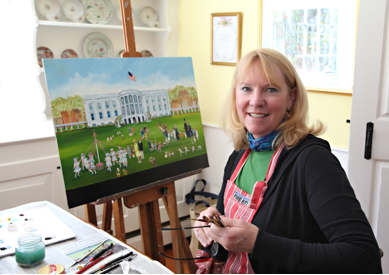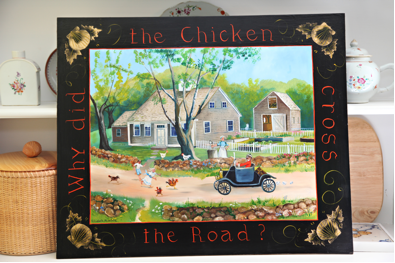Elizabeth Mumford: The Art of Marketing Nostalgia
by Jane Schaller
Take a reverent, spirited Indiana farm girl, fold in dollops of raw artistic talent, and sprinkle with plenty of genteel, classic culture. Gently toss with integrity, then marinate inside a fanciful Cape Cod home until ripe and ready to sizzle.
Yield: The rare, smooth blend of deep artistic passion, accentuated by enduring commercial success that is Elizabeth Mumford.

"I'm one of those persons who, ever since I was little, I was always painting and drawing and doing artwork," Liz recalls "Fortunately my mother was very encouraging of me." But there were not many opportunities to nurture a budding artist in the rural elementary school she attended.
That changed when she was sent to a boarding school in Michigan that possessed a strong art program. At twelve years old, she was all at once immersed in an array of art classes and experiences, including one seemingly innocuous course offering: Life Art.
"We freshmen didn't know what we signed up for," noted Liz. "We were a little surprised the first day of class." Life Art turned out to be live nudes.
"I thought we would be out drawing trees and plants," she grinned.
Elizabeth Mumford's eagerness for learning took her to Smith College where she majored in Studio Art, while satisfying her father's preference for a classical education by taking a repertoire of liberal arts courses. Her fervor for knowledge was matched by a budding fondness for teaching, primarily Art History. First at Seabury Hall in Hawaii for four years, followed by five more years back in the Indiana farm country of her roots, teaching elementary school art at a private school.
The decision to pursue a career as an artist was yet to come.
"I knew I wasn't going to go out painting for a living," she reflected, "I mean, that's a very difficult thing to do."
The desire to enhance her skill set beckoned. Spending two lively years taking art and anatomy courses at Tulane University, while socializing with family and friends, improved her confidence and generated layers of experience.
Summers spent at the family home in Hyannis Port became a year-round residence when her mother handed the home over in the early 1980s. The fact that it was not heated created only momentary angst. "I bought a wood stove and learned how to use that and I lived very happily here, painting."
Although trained to work in contemporary abstract expressionism, she bucked the system and chose to paint what she always loved: American Folk Art. She was inspired early on by classes taken in Tole painting – decorative brushwork on tin, often seen on backs of chairs – from a teacher in Yarmouth Port. This, among other influences, led to further interest in using oils on canvas to create a similar motif.
It was a slow process in the beginning, studying and copying the methods from books in order to get the feel of it. Later, she became inspired by words found in Benjamin Franklin's Poor Richard's Almanac and lyrical sea shanties, although many of those proved to be too rowdy for the desired wholesomeness of the works. After experimenting with red and green borders, she chose black, as it provided the ultimate contrasting backdrop for the colors it enclosed.
Eventually, it all came together. Fanciful nostalgic nautical designs, enveloped by lyrical sayings and the trademark bronze scallop shells stenciled on all four corners.
"I lived happily here painting," Elizabeth reflected. "I was lucky; hit it in the early 80s. The economy was doing well, people were buying art and I was painting something new and different."
Liz has done a mixture of commissioned paintings and those of her own inclination, the latter of which have been both sold in galleries and through signed and numbered limited prints.
"Back in the '80s when things were selling rapidly, I had a certain price point for a painting. (But) there was a demand for people that wanted something less expensive, and they liked these images, so that clearly the way to go was to get prints made."

Jane Schaller is our 'web princess' and a contributing writer for this magazine. She has an AS in Web Design and Development from Cape Cod Community College.
She is a freelance web designer and writer. Mother to three grown daughters, she resides in the Web Princess palace with her dog, Wilbur, cat, Jack and husband, Bill.

Photo courtesy of Lauren Clough Photography www.laurenclough.com
She chose to add her more popular works to note cards, although doing so is not cost-effective. "You don't make money on the note cards," Liz stressed. "If you make three cents, you're lucky. But it's a great way to get your images out."
This was a compelling way to market herself because after buying the cards, consumers would send friends and loved ones cards with Liz's signature at the bottom. Flip the card over and there is her email address on the back. "People will say 'Oh look at this' and they can go online and find me."
Half the battle for an artist is to get their name out there and Liz has exceeded that goal.
"People will come up and say, 'I have ten of your prints!' and I say, 'Great you have almost as many as my mother does'! But when you hear people say that over and over again, you realize, oh man, I am really saturating the market."
Liz recognized that it was time to broaden her following by tweaking the Cape Cod nuances and creating more of a New England flavor. She has already tested the water by marketing in Virginia, Barnegat Bay, New Jersey, Mystic Seaport and Fairfield, Connecticut.
No matter how celebrated an artisan is, if the economy is suffering, so will their livelihood. "The last few years have been very difficult because people aren't buying paintings. The market for people buying artwork is certainly not what it used to be," Liz shared.
"Artists are the first ones to get hit any time there is a downturn. Cars and art. People have to have a car, but nobody has to have art. Until the housing market picks up and people are redecorating, that's when things will get going again."
Do not think that a rough economy has kept Liz from embracing her craft. "If you don't paint all the time you start losing your edge. You don't get better if you don't paint," she affirmed.

Liz keeps grounded in the world of beauty and is always up for a challenge. Inspired during Easter by a church friend, she has been trying out a technique using beeswax drawn on hollowed eggs with a special tool to make "Ukrainian" eggs. "It's difficult in that you are drawing lines on a curved surface; (it's) quite a challenge and needs a steady hand."
Liz continued to maintain her painter's edge when recently selected as one of ten artisans to participate in Sotheby's "Every House is a Masterpiece" two-day event. Stationed at an open house in South Dennis (presented by her son and Sotheby agent, Samuel Wilson) she worked on a painting that featured a house similar to the one on display.
"Sotheby's has some pretty nice houses and to be invited to be a part of this group of artists was a very nice thing."
The waning economy has not kept Liz Mumford away from her other devotion, teaching. She introduces students at Cape Cod Community College to Art History with great enthusiasm and pleasure. "I can read the book and sit there but you have to have it in your heart to teach well."
So, how did this Indiana farm girl end up becoming one of the most recognized and revered artists on Cape Cod? She found her niche, and understood a fundamental Truth.
"If you have something that you can do, that people want, you can sell. Hopefully you want to paint—you want to work. If you don't, that means you probably aren't going to be a very good artist."
To see more of Elizabeth Mumford's artwork visit: www.elizabethmumford.com
 |
